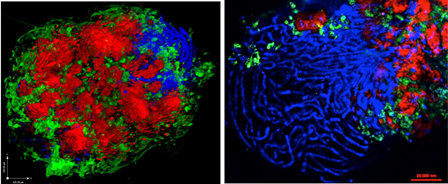Evaluation of an Algicidal Compound Produced by Shewanella sp.
Dinoflagellates are a group
of algae
that include many toxic
species, such as those that cause “red tides” in the Gulf of Mexico and
also those that
are responsible for paralytic and
neurotoxic shellfish poisonings. Dinoflagellate blooms in the
mid-Atlantic
region also pose a serious threat to human health and marine life, yet
there
are no measures in place for rapid response and mitigation of
harmful
dinoflagellate blooms in this region. In previous research at UD, we
investigated a bacerial algicide that kills dinoflagellates but has no
impact on the growth of other classes of
phytoplankton. Our
data suggest that the algicide may be an effective tool for controlling
dinoflagellate growth, precisely targeting these species without
impacting
other algal groups. While this algicidal
compound may someday provide a
means to control or even prevent harmful dinoflagellate
blooms, more
work is needed before it can be safely used in the environment.
As part of our current research on algicidal bacteria, we are isolating the algicidal compound for
characterization and to evaluate its effects on other ecologically or
economically important species, such as copepods, oyster and crab
larvae and juvenile finfish.
Investigators: Kathryn J. Coyne (kcoyne@udel.edu), Mark E. Warner (mwarner@udel.edu), Jonathan Cohen (jhcohen@udel.edu) and Timothy Targett (ttargett@udel.edu). Funded by a grant from the National Oceanic and Atmospheric Administration (NOAA).
A related project is evaluating an environmentally-friendly approach to preventing harmful dinoflagellate blooms by developing matrix-associated algicidal bacteria. Here, the bacteria are attached to, or embedded in, a porous matrix that can then be deployed in areas at risk dinoflagellate blooms. The matrix allows diffusion of algicidal compounds while preventing dispersal of bacteria.
Investigator: Kathryn J. Coyne (kcoyne@udel.edu). Funded by Delaware Sea Grant.
Gyrodinium
instriatum: (left) control, (right) after exposure to algicide. Cells
are dyed green (membranes), red (autofluorescence due to chloroplasts)
and blue (DNA).

